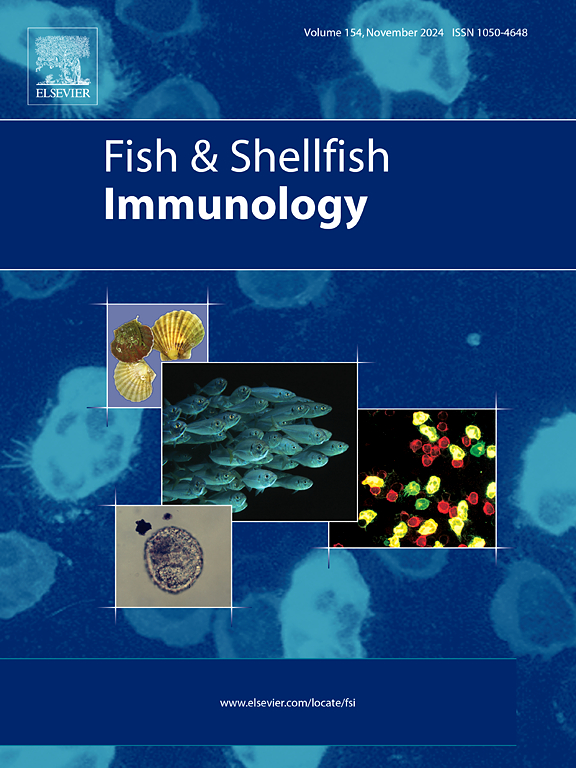ARRDC3, a novel α-arrestin, modulates WSSV replication and AHPND pathogenesis in Litopeneaus vannamei
IF 4.1
2区 农林科学
Q1 FISHERIES
引用次数: 0
Abstract
Although shrimp are a valuable protein source, shrimp aquaculture has numerous challenges from various infectious diseases and understanding molecular mechanisms of disease pathogenesis is crucial for disease management. In this study, a gene-to-gene correlation network generated from a transcriptomic database of the stomach of shrimp infected with acute hepatopancreatic necrosis disease (AHPND) was used to identify a new α-arrestin, termed arrestin domain containing-3 gene (LvARRDC3), with crucial roles in development of both AHPND and white spot disease (WSD). Double stranded RNA-mediated silencing or plasmid-mediated overexpression of LvARRDC3 gene significantly decreased expression of WSSV genes (IE1, VP28, and ICP11) and viral genome copy numbers. Nevertheless, in AHPND, silencing the LvARRDC3 gene increased the AHPND-associated plasmid and Pir toxins copy numbers, whereas overexpression of LvARRDC3 had the opposite effect. An in vitro pathogen binding assay with recombinant LvARRDC3 protein produced robust binding to WSSV virions and AHPND-causing V. parahaemolyticus. Moreover, based on immunofluorescence, LvARRDC3 was localized in the cytoplasm of Spodoptera frugiperda (Sf9) insect cells. Therefore, we inferred that LvARRDC3 has a role in pathogen internalization, making it a valuable target for addressing AHPND and WSD and also a biomarker for marker-associated shrimp breeding.
ARRDC3是一种新型α-抑制蛋白,可调节凡纳滨对虾WSSV的复制和AHPND的发病机制。
尽管对虾是一种宝贵的蛋白质来源,但对虾养殖面临着各种传染病的挑战,了解疾病发病的分子机制对疾病管理至关重要。本研究利用侵染急性肝胰腺坏死病(AHPND)的虾胃转录组学数据库建立基因-基因相关网络,鉴定出一种新的α-抑制蛋白,称为抑制蛋白结构域-3基因(LvARRDC3),该基因在AHPND和白斑病(WSD)的发展中都起着至关重要的作用。双链rna介导的LvARRDC3基因沉默或质粒介导的LvARRDC3基因过表达显著降低WSSV基因(IE1、VP28和ICP11)的表达和病毒基因组拷贝数。然而,在AHPND中,沉默LvARRDC3基因会增加AHPND相关质粒和Pir毒素的拷贝数,而过表达LvARRDC3则会产生相反的效果。重组LvARRDC3蛋白与WSSV病毒粒子和引起ahpnd的副溶血性弧菌进行了体外病原体结合试验。此外,基于免疫荧光,LvARRDC3定位于Spodoptera frugiperda (Sf9)昆虫细胞的细胞质中。因此,我们推断LvARRDC3在病原体内化中发挥作用,使其成为解决AHPND和WSD的有价值的靶点,也是标记相关对虾育种的生物标志物。
本文章由计算机程序翻译,如有差异,请以英文原文为准。
求助全文
约1分钟内获得全文
求助全文
来源期刊

Fish & shellfish immunology
农林科学-海洋与淡水生物学
CiteScore
7.50
自引率
19.10%
发文量
750
审稿时长
68 days
期刊介绍:
Fish and Shellfish Immunology rapidly publishes high-quality, peer-refereed contributions in the expanding fields of fish and shellfish immunology. It presents studies on the basic mechanisms of both the specific and non-specific defense systems, the cells, tissues, and humoral factors involved, their dependence on environmental and intrinsic factors, response to pathogens, response to vaccination, and applied studies on the development of specific vaccines for use in the aquaculture industry.
 求助内容:
求助内容: 应助结果提醒方式:
应助结果提醒方式:


